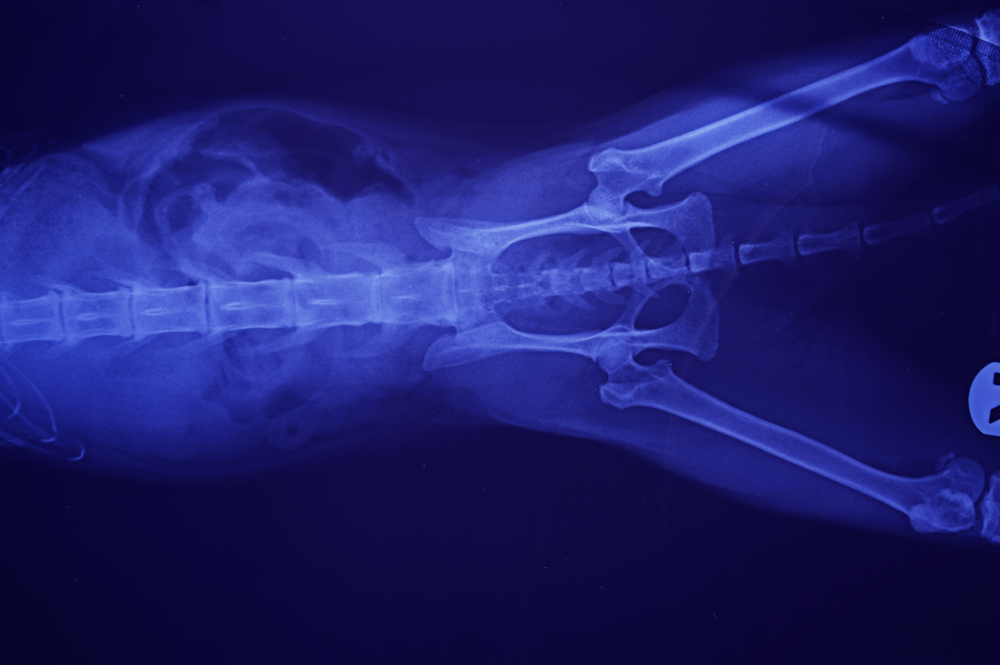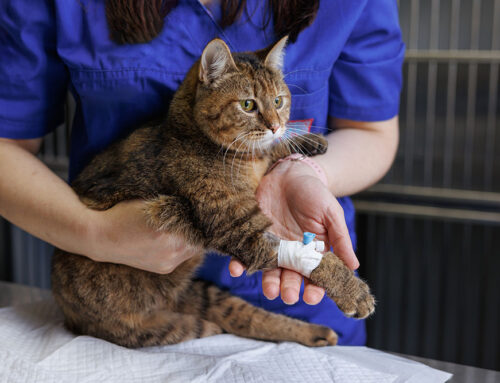Middle-aged and older dogs are frequently afflicted with joint disease, usually as a result of aging and wear and tear. Arthritis in the hip joints can often be blamed on hip dysplasia. Affected dogs often develop the disorder during puppyhood, but may not show pain or mobility problems until later in life. The Memorial Villages Animal Hospital team answers frequently asked questions about hip dysplasia risks, signs, and treatment options to help dog owners understand and manage this disease.
Question: What is canine hip dysplasia?
Answer: Hip dysplasia is a developmental joint disorder that affects many species, including humans, cats, and dogs. Dogs with hip dysplasia are born with genes that code for abnormal pelvis and femur growth that causes the ball and socket to fit poorly when the puppy reaches adult size. The poor fit causes loose, sloppy joint movements that damage the cartilage and other structures inside and eventually lead to arthritis.
Q: Which dogs are most affected by hip dysplasia?
A: Hip dysplasia was thought to most commonly occur in large- and giant-breed dogs, but surveys from the Orthopedic Foundation of America (OFA), which examines purebred dogs’ X-rays to “grade” their hips, show that many other breeds also have this problem. The issue may simply be recognized more in large breeds, because their signs tend to be more severe than in smaller dogs. According to 2016 OFA data, popular dog breeds with high hip dysplasia percentages include the pug, bulldog, other bully breeds, and various terrier breeds. Incidence in German shepherds and Labradors has likely improved because breeders are more aware of the problem.
Q: Is hip dysplasia painful?
A: Not all dogs with hip dysplasia are painful, but many will develop pain as their joint damage and arthritis progress. This could happen as early as 6 months of age or far later into their senior years. Hip dysplasia pain is treatable with a multi-modal approach that is customized to each individual dog.
Q: How do I know if my dog has hip dysplasia?
A: Hip dysplasia is diagnosed in several different ways. If you want to be as proactive as possible, you can have your young puppy screened with a sedated PennHip X-ray examination, which is offered only by select veterinarians with specialized training and certifications. This is the only test that will reliably identify a hip problem before the pet reaches skeletal maturity at 1 to 2 years of age.
Older pets can be screened with hip X-rays once they have reached their full adult size, or if they develop hip dysplasia or hip arthritis signs. Signs to watch for include:
- Refusal to exercise or play
- Stiffness or lameness in the hind end, especially after activity
- Bunny-hopping gait
- Trouble with jumping or stairs
- Visible or audible hip cracking or popping
Q: Can surgery fix my dog’s hips?
A: Surgery is often the best option to restore function and reduce pain. Your dog’s age, size, activity level, symptom severity, and the presence or absence of arthritis in the hip joints will determine the best surgical procedure. The best outcomes are possible in dogs younger than 10 months who undergo corrective procedures that change how their bones grow and align. Older dogs who have surgery will see improvement, but not complete resolution, of their signs. Talk to our veterinary team about surgical options, or find a specialist surgeon here.
Q: Do all dogs with hip dysplasia need surgery?
A: Not everyone can afford hip dysplasia surgery, which generally costs several thousand dollars per hip. For pet owners who do not wish to pursue surgery, and dogs with mild or moderate symptoms, medical management is the next best option. Medical management may include:
- Medications
- Supplements
- Physical therapy
- Laser and other alternative therapies
- Controlled exercise
- Weight management
- Household modifications
Q: How do I decide between medical and surgical management for my dog’s hip dysplasia?
A: You and our veterinary team will work together, sometimes in concert with a veterinary specialty surgeon, to devise the best treatment plan for your individual situation. Surgery may be more economical than medical management in many cases, depending on the dog’s age, but every pet is different.
Q: Can you test breeding dogs for hip dysplasia to reduce the incidence in puppies?

A: Newer genetic tests are being developed as more and more hip dysplasia-related genes are discovered, but these tests are not widely available for all breeds. Gene expression is complex and can be influenced by many factors, which is the reason breeders have not been able to completely eliminate the problem. OFA and PennHip screening tests are currently the best methods to screen breeding dogs, but they don’t guarantee all puppies will have healthy hips.
Joint diseases, including hip dysplasia, can cause your dog pain or discomfort that limits their activity and quality of life. Our Memorial Villages Animal Hospital team recommends closely watching all dogs for hip dysplasia signs, because you may not realize your dog has the problem until later in their life. Annual examinations can also help detect problems earlier—call us to schedule your dog’s next visit.









Leave A Comment